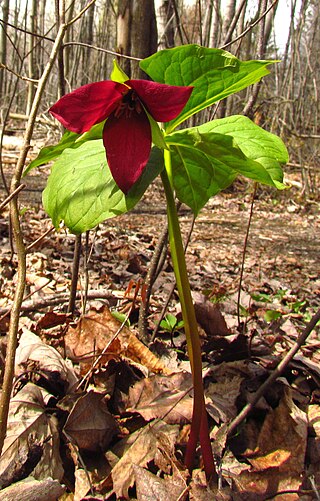
Trillium erectum, the red trillium, also known as wake robin, purple trillium, bethroot, or stinking benjamin, is a species of flowering plant in the family Melanthiaceae. The plant takes its common name "wake robin" by analogy with the European robin, which has a red breast heralding spring. Likewise Trillium erectum is a spring ephemeral plant whose life-cycle is synchronized with that of the forests in which it lives. It is native to the eastern United States and eastern Canada from northern Georgia to Quebec and New Brunswick.

Persicaria maculosa is an annual plant in the buckwheat family, Polygonaceae. Common names include lady's thumb, spotted lady's thumb, Jesusplant, and redshank. It is widespread across Eurasia from Iceland south to Portugal and east to Japan. It is also present as an introduced and invasive species in North America, where it was first noted in the Great Lakes region in 1843 and has now spread through most of the continent.

Selenicereus costaricensis, synonym Hylocereus costaricensis, known as the Costa Rican pitahaya or Costa Rica nightblooming cactus, is a cactus species native to Central America and north-eastern South America. The species is grown commercially for its fruit, called pitaya or pitahaya, but is also an impressive ornamental vine with huge flowers. The species may not be distinct from Selenicereus monacanthus.
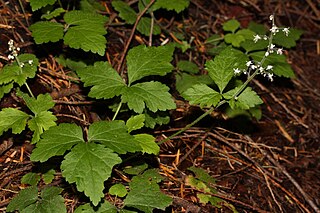
Tiarella trifoliata, the three-leaf foamflower, is a species of flowering plant in the family Saxifragaceae. The specific name trifoliata means "having three leaflets", a characteristic of two of the three recognized varieties. Also known as the laceflower or sugar-scoop, the species is found in shaded, moist woods in western North America.

Salvia indica is a species of herbaceous perennial plant belonging to the family Lamiaceae. It is native to a wide region of Western Asia that includes Israel, Iraq, Iran and Turkey. It was first described by the taxonomist Carl Linnaeus in 1753. It is unknown why he gave it the specific epithet indica, since the plant is not from India. While Salvia indica is classified as a herbaceous perennial, in cultivation individual plants often live no longer than two years.

Sarracenia alabamensis, also known as the cane-brake pitcher plant, is a carnivorous plant in the genus Sarracenia. Like all the Sarracenia, it is native to the New World. S. alabamensis subsp. alabamensis is found only in central Alabama, while subsp. wherryi is found in southwestern Alabama, eastern Mississippi and Florida. It is sometimes treated as two subspecies of S. rubra.

Salvia canescens, the hoary sage, is a herbaceous perennial that is endemic to the Caucasus mountains. The specific epithet, canescens, refers to the off-white hairs covering the leaves.

Euphronia is a genus of three species of shrubs native to northern South America and is the only genus in the family Euphroniaceae. It was previously classified in the Vochysiaceae family and elsewhere due to its unique floral features, but the APG III system of 2009 recognized Euphroniaceae as distinct and placed Euphronia in it. Based on molecular data from the rbcL gene, it is sister to the Chrysobalanaceae.
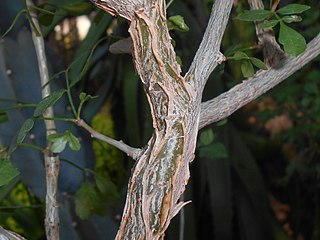
Commiphora habessinica, sometimes known as Abyssinian myrrh or the Yemen myrrh, is a plant native to northeast Africa and the Arabian peninsula, including Djibouti, Eritrea, Ethiopia, Zambia, Malawi, Oman and Yemen. It was first described by Otto Karl Berg in 1862 as Balsamodendrum habessinicum from northeast Africa. It was then transferred to the genus Commiphora by Adolf Engler in 1883, but given the name Commiphora abyssinica, an orthographical variant. It can be recognised by its simple, serrate leaves and by the pseudo aril, covering the seed, which has four almost linear arm-like lobes.

Chenopodiastrum is a genus of herbaceous flowering plants in the family Amaranthaceae. The genus was formally described in 2012. The 5 species occur in Eurasia, North Africa, and North America.
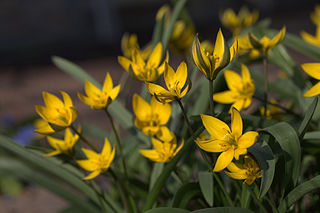
Tulipa dasystemon, synonym Tulipa neustruevae, is a bulbous herbaceous perennial species of tulip (Tulipa) in the family Liliaceae. It belongs to the section Biflores.

Trichoglottis atropurpurea, the dark purple trichoglottis, is a species of orchid endemic to the Philippines. This hot to warm growing epiphyte was first found growing in mangrove swamps in the islands of Biliran, Catanduanes, Mindanao and Polillo. The plant shares the same appearance with T. philippinensis except for the rich dark color of the blooms and slight variation of the perianth. This species was first described in 1877 by the German botanist Heinrich Gustav Reichenbach, an expert on the orchid family. At that time, thousands of newly discovered orchids were being sent back to Europe, and he was responsible for identifying, describing and classifying many of these new discoveries.

Sisyrinchium campestre, the prairie blue-eyed grass or white-eyed grass, is a small herbaceous perennial plant in the iris family, native to prairie and meadow in the central United States and in extreme southern Manitoba.

Hypericum przewalskii, commonly called Przewalski's St. John's wort, is a flowering plant in Hypericumsect. Roscyna that is native to China.

Symphyotrichum patens, commonly known as late purple aster or spreading aster, is a perennial, herbaceous plant found in the eastern United States.
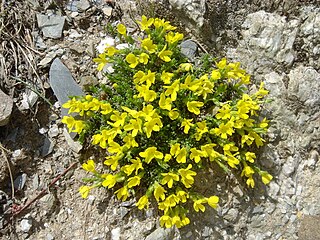
Androsace vitaliana is a species of plant in the primrose family, Primulaceae. It was previously known by the synonym Vitaliana primuliflora. Native to the high mountains of Europe, it is cultivated as an alpine garden plant, being considered easy to grow in well drained soil in a sunny position.
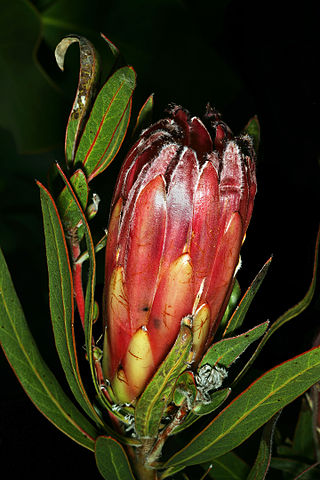
Protea burchellii, also known as Burchell's sugarbush, is a flowering shrub in the genus Protea, which is endemic to the southwestern Cape Region of South Africa.
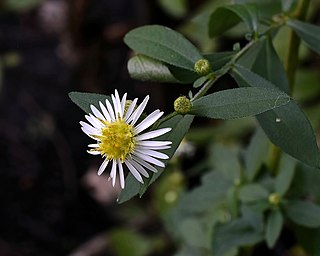
Symphyotrichum ontarionis is a species of flowering plant in the family Asteraceae native to eastern North America. Commonly known as Ontario aster and bottomland aster, it is a perennial, herbaceous plant that may reach heights of 120 centimeters. Each flower head has many tiny florets put together into what appear as one.

Kimnachia is a monotypic genus of cacti. Its only species is Kimnachia ramulosa, synonym Pseudorhipsalis ramulosa, which is native from southern Mexico to northern South America and also found in Jamaica.
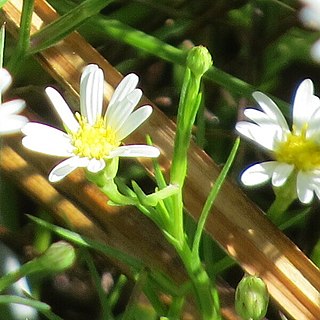
Symphyotrichum potosinum is a species of flowering plant in the family Asteraceae native to Mexico and the U.S. state of Arizona. Commonly known as Santa Rita Mountain aster, it is a perennial, herbaceous plant that may reach heights of 15 to 45 centimeters.




















